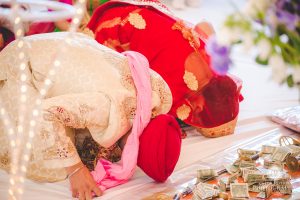Speech Delivered by a satsanggi:
This article is a speech delivered by a satsanggi during a wedding. He had asked for Bhai Manjeet Singh Ji’s views and input in crafting the speech

Bhai Manjeet’s reply:
After saying Waheguru Ji Ka Khalsa Waheguru Ji Ki Fateh
I would start by saying, how inadequate I feel in the presence of the Guru to speak of Bani. But I have been requested by the family of the groom to give a short synopsis of the marriage hymns which are read and sung at all Sikh marriages.
The marriage ceremony is called anand karaj. Anand means bliss. So, the focus is on bliss for the lucky couple.
Guru Ramdas Ji, the 4th Guru of the Sikhs did not write the wedding hymns (commonly known as laavan) for a human marriage. The Gurus were drenched with love for God. Thus, the laavan hymns are first and foremost about the spiritual journey which culminates in union with God. Merger with God is the real “anand” – the true bliss.
The laavan are a 4-stanza prayer found at Ang 773 – 774 of SGGS Ji. Although Sikh history is still not conclusive on this, it is believed that these laavan hymns were first used at the wedding of the 5th Guru, Guru Arjun Dev Ji (1563 – 1606). The practice prior to that had been to circumambulate around the fire like the Hindus.
On the spiritual path in Sikhism, we are told there are 4 steps to the spiritual ladder. These steps are known as “khand” in Japji Sahib.
The 1st stage is dharam khand, where we have emphasis on duties. In the 2nd stage gyan khand, one becomes aware that he is part of a huge fascinating system of God and must start eroding his ego. In the 3rd stage of saram khand, spirituality becomes fine-tuned in sadhsangat and the driving force is no longer rules as in the 1st stage, but rather love for God. In the laavan hymns this love or yearning for God is called bairaag.
In the 4th stage, grace is granted to the Sikh and he now is in a state of poise and eternal calmness. He sees God’s jot – Divine Spark of existence everywhere.
The 5th stage is Sachkhand which can never be adequately described since God Himself resides at that plane. That dimension “Sachkhand vassay Nirankar” is beyond words.
Interestingly, these 4 stages are also found in Islam and Guru Arjun Dev Ji at Ang 1083 mentions these 4 stages. Firstly, we have shariah. “Shara shariat le kamahvo”. In the 2nd stage of the spiritual ladder we have “tarikat” thus Guru Ji says “tarikat tarak khoj tolavho” the 3rd stage being “marifatt” – “marifatt man maro abdallah”.
The final stage of Islam is merger with Hakikat – the Truth ” milho hakikat jit firr na marra.”
In the Bhagvat Gita, a similar journey of spiritual ascent is described by Krishna Ji to Arjun.
That is the spiritual backdrop to these marriage hymns. The virtues needed on the spiritual journey leading to blissful union with God are also necessary for a successful physical union between man and wife.
In essence, the 1st stanza
ਪਹਿਲੜੀ ਲਾਵ ਪਰਵਿਰਤੀ ਕਰਮ ਦ੍ਰਿੜਾਇਆ ਬਲਿ ਰਾਮ ਜੀਉ ॥
“Har pehlarhi laav parvirti karam dhriaaya bal raam jio..” the duties of family life have been stressed. So, for a successful marriage the couple will have to follow certain rules or duties. Of honesty, sincerity and to be loyal to each other.
The 2nd part of the laavan hymn says
ਹਰਿ ਦੂਜੜੀ ਲਾਵ ਸਤਿਗੁਰੁ ਪੁਰਖੁ ਮਿਲਾਇਆ ਬਲਿ ਰਾਮ ਜੀਉ ॥
“Har dujhri laav satgur purakh milaya bal raam jio. Nirbhao bhay man hoi haumai mail gavahiya bal raam jio.” Thus, in any happy marriage the partners will have to erode their egos, their haumai.
In the 3rd stage Guru Ji says there must be love and enthusiasm.
ਹਰਿ ਤੀਜੜੀ ਲਾਵ ਮਨਿ ਚਾਉ ਭਇਆ ਬੈਰਾਗੀਆ ਬਲਿ ਰਾਮ ਜੀਉ ॥
“Har tijree laav man chaoo bheya bal raam jio.” There must be “chao” to be in each other’s company and to receive the views of your spouse with enthusiasm to form a strong foundation to the marriage.
In the final stage of union there is calmness and equipoise of the mind.
ਹਰਿ ਚਉਥੜੀ ਲਾਵ ਮਨਿ ਸਹਜੁ ਭਇਆ ਹਰਿ ਪਾਇਆ ਬਲਿ ਰਾਮ ਜੀਉ ॥
“Har chauthri laav man sahaj bheya har paiya bal raam jio..” Similarly, on a human level the physical union must achieve a quiet deep understanding between man and wife where any situation is faced with an inner peace and consensus.
This sadhsangat ji is the essence of the 4 laavan. As the couple walks around SGGS Ji 4 times as the laavan are sung by the ragis, the couple is declaring to all present that SGGS Ji shall be the central focus of their lives.
We as the sangat should quietly bless this young couple to enjoy wedded bliss.
Waheguru Ji Ka Khalsa Waheguru Ji Ki Fateh.
Manjeet Singh (August 26, 2016)


